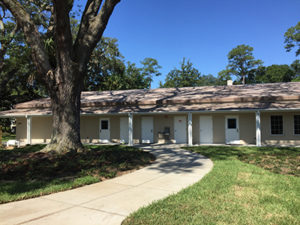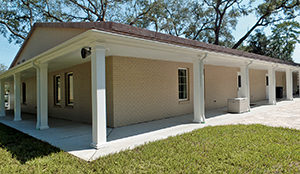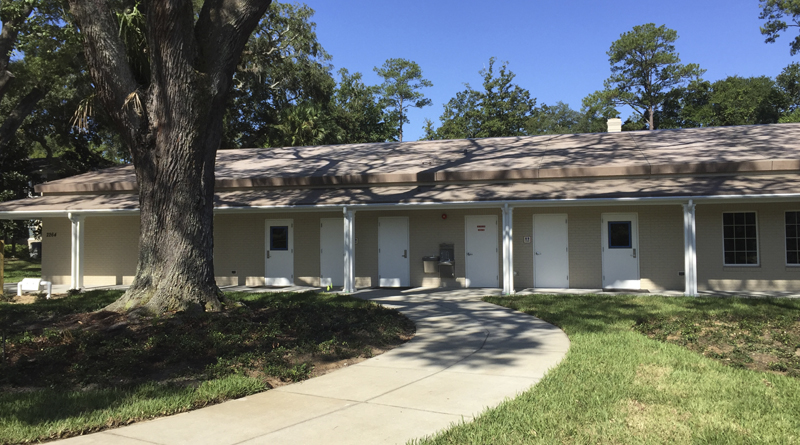Part 2: From Portable to Precast Concrete
By Kate Gawlik
Public and private schools across the country have a growing situation to solve: While increased enrollment benefits a school, filling classrooms beyond capacity is not conducive to a positive learning environment. Some schools have expanded with portable buildings placed onsite. Although functional, these buildings are not always aesthetically pleasing or safe during inclement weather, and the long-term costs from multiple replacements are a factor.

Part 1 of this article discussed The Bolles School in Jacksonville, Fla. — which added three modular trailer-type buildings to its Middle School Bartram Campus in the 1990s for needed classroom space. The campus underwent another change in 2016 when the structures were replaced with a unique custom-engineered precast concrete solution to create the new science and technology building, called Tarver Hall.
Project requirements included that the building be completed during summer 2016, when students were not on campus. The building was also required to meet or exceed building codes, wind loads and wind standards, and the project could not impact existing oak trees on the site.
Leesburg Concrete Co. Inc., of Leesburg, Fla., drew from its 30 years of experience in the education market to take on the challenging. An Easi-Set Building licensed producer, the company embraced the project as an opportunity to put its innovative and technology-driven savvy to the test with a highly custom-engineered building designed to match the existing campus aesthetic.
Precast Concepts
Schools in high-wind zones have special building considerations, but structures across the country can use precast concrete buildings to address their own environmental conditions. Easi-Set and Easi-Span precast buildings, made by Midland, Va.-based Easi-Set Worldwide, for instance, are composed of 100 percent concrete with UL-752 level 5 ballistics-resistant components, and many larger buildings are certified by third-party engineers.

Photo Credit (all): Leesburg Concrete
Precast concrete buildings are available with a range of interior and exterior outfitting options, including HVAC, lighting, plumbing and electricity. Further customization is available throughout a building from the walls to the roof and the floor. Different textures and colors allow design goals to be achieved.
“Just like at Bolles Middle School, aesthetics can be matched or something totally unique can be created,” said Chris Reese, an engineer with Easi-Set Worldwide. “Customization is something that Easi-Set producers do so well, and they work with each customer to ensure a building is a perfect fit for its environment.”
Compared to other structures, precast concrete buildings can be installed faster. The length of time depends of the size of the building, but a typical install takes days, not weeks. Costs are less than other building methods because precast concrete is an fast and efficient way to build, saving time and money during the manufacturing process and on a jobsite.
School officials should consider that Easi-Set Buildings are available for a wide range of campus needs, including classrooms, concessions stands, dugouts, restrooms, storage facilities and more. They also should note that not all manufacturers create structures to the same level of quality. Building owners should work with producers and their design team to compare manufacturers’ practices, testing and capabilities to ensure quality standards are met.
Lessons Learned
At Bolles, the team had 70 days to complete the entire project, so it was ready for the start of a new school year. The site prep alone took three weeks. The fully fitted and landscaped Tarver Hall met the completion date on time with the structure set in less than three weeks.
Leesburg Concrete has manufactured many precast concrete buildings, but this truly unique facility showcases the staff’s level of experience and ingenuity when presented with unique circumstances.
“We could not have turned over a completely pre-assembled structure to the school because that would not have met its needs,” Kirk Rouse, vice president of Leesburg Concrete said. “We took what we do well and worked with our Easi-Set team to build a strong floor base for the building, while we engineered the roof and walls to blend in with the campus and stand up to Mother Nature. This project was a learning experience for all of us, and the final outcome is a testament to our level of commitment to each customer.”
Kate Gawlik is a freelance writer based in Lockport, Ill., specializing in all things construction, design and engineering.

